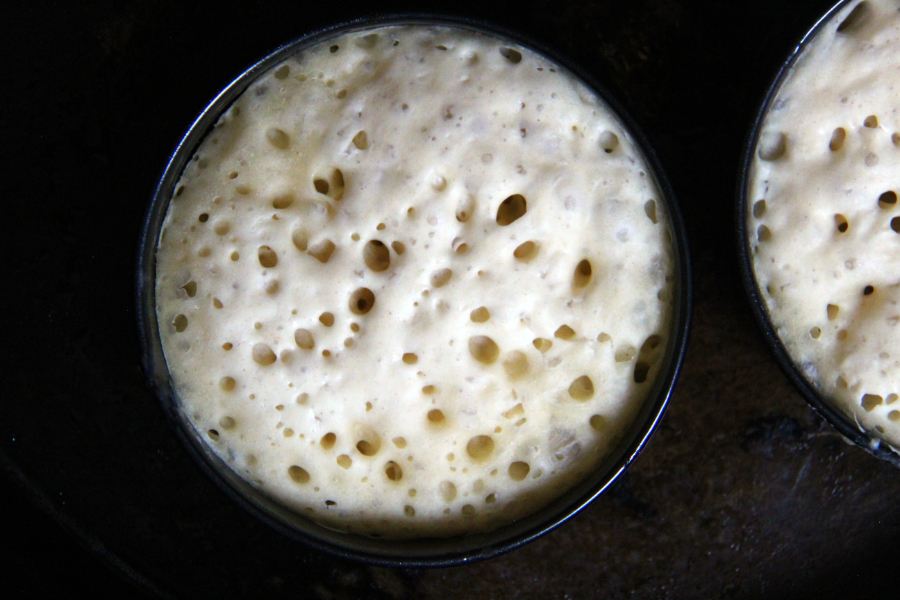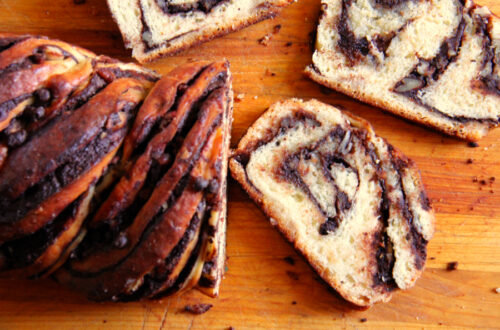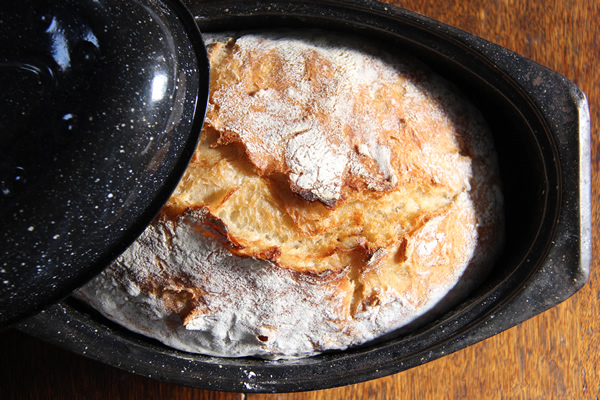On a recent trip to England, we fell hard for the hot, buttery crumpets served on the 10:03 train from London’s King’s Cross Station to Leeds. We’d splurged on first class with meal service—well worth it just to experience these soft, griddled treats that soaked up butter like sponges.
Make these beauties for breakfast, brunch or tea, and you too will understand why Brits love their crumpets.
Not English Muffins
While crumpets are English and muffins, they are not English muffins. If you crossed English muffins with pancakes, you’d get something like crumpets.
Crumpets start with a bubbly yeasted batter, not a dough like English muffins. The batter cooks in rings on a griddle or in a heavy skillet. As it heats, its bubbles pop into a myriad of tiny holes—the crumpet’s trademark. The crumpet ends up with a crispy bottom, a delicate and spongy middle, and a hole-studded top.
Unlike English muffins, which get split and toasted, crumpets are usually served uncut and only lightly toasted on top. So when you slather butter onto a hot crumpet, it soaks way down into all those lovely little pores. As with English muffins, crumpets make an excellent butter delivery system. And a perfect base for jam, marmalade, or Marmite if you’re brave.
The Crumpet Challenge
According to the menu, the train served us Warburtons, UK’s most popular and beloved commercial crumpet. So we just needed a copycat recipe.
Luckily, Warburtons had revealed their secret family recipe during the pandemic to show compassion for house-bound crumpet-lovers.
We followed the recipe and cranked out Warburtons crumpets. Batches and batches of them. They looked gorgeous, with perfect little signature holes. But they always came out a little gummy. Their texture reminded us of an underdone pancake. The crumpets we enjoyed on the train were higher, lighter and had a better chew.
Like pancakes, crumpets take some practice. So we tried adjusting beating time, proofing time, cooking time, cooking surface, size of crumpet ring, cooking temperature, and even types of flour. But we just couldn’t get it right.
Now who would we trust to tell us how to make better crumpets? Paul Hollywood, the iconic baker and judge from The Great British Baking Show, of course. He once said, “I love crumpets. You can’t beat a good homemade crumpet.” What he really meant was, “You can’t beat my homemade crumpets.”
So we had to put his recipe through our technical challenge.
While his recipe takes more time than Warburtons, it’s worth it. In batch after batch it consistently produced lovely hole-studded crumpets with more structure and flavor than Warburtons.
In fact, we could imagine Paul Hollywood pinching off a piece of a Warburtons crumpet, rolling it into a little ball, and declaring it “goomey.”
We wrote Warburtons for advice on solving this gumminess problem, but we haven’t heard back. We suspect their secret to great crumpets lies somewhere in a proprietary manufacturing process.
In the meantime, we crown Paul Hollywood the Crumpet King. And thank him with a hearty handshake.
Paul Hollywood’s Crumpets
Adapted from Paul Hollywood’s Bread by Paul Hollywood
Necessary equipment:
At least four 4-inch metal nonstick crumpet rings (such as those by Datanya ); heavy large frying pan or griddle
Recommended:
Kitchen scale, large ice cream scoop
Weigh ingredients for the best results.
Makes about 10 crumpets
-
- 175 g bread flour (almost 1½ cups)
-
- 175 g all purpose flour (almost 1½ cups)
-
- 14 g instant yeast (about a tablespoon)
-
- 1 teaspoon sugar
-
- 350 ml warm milk (1½ cups)
-
- 150–200 ml tepid water (½ – ¾ cups)
-
- ½ teaspoon baking soda
-
- 1 teaspoon salt
-
- Vegetable oil for cooking
Allow standing time for the batter of 1 hour plus 20 minutes.
-
- Combine flours in a large bowl and stir in the yeast. In a bowl, dissolve the sugar in the warm milk, then pour onto the flour mixture. Using a wooden spoon or dough whisk, beat the mixture until the batter is smooth, about 3-6 minutes. It’s hard work, but don’t give up. It’s necessary to develop the protein in the batter and produce those characteristic holes as they cook.
- Cover the bowl with plastic wrap or a tea towel and let stand for about 1 hour, allowing the mixture to rise and begin to fall. This allows time for the gluten to develop.
- In a large bowl, mix 150ml of the tepid water with the baking soda and salt. Stir this mixture into the batter until evenly combined, then gradually stir in as much of the remaining water as you need to get a thick dropping consistency. Cover the bowl and let batter rest for about 20 minutes.
- Lightly grease a griddle or heavy frying pan using a paper towel dipped in oil.
- Grease the insides of at least four 4-inch metal nonstick crumpet rings. (We recommend Cake Goop).
- Heat griddle or pan on medium-low heat.
- Do one test crumpet first, because, like pancakes, the first batch is rarely as good as the rest. Place a greased crumpet ring on the griddle or pan. Using an ice cream scoop, release enough batter into the ring to reach just below the rim. Watch the temperature—low and slow is better than hot and fast.
- After 6–8 minutes, the bottom should be browned and the rest almost cooked through. It will be nearly ready when the top looks almost set and most of the bubbles that have formed on the surface have burst. When the crumpet is ready to turn, bubbles will stay open rather than fill up with liquid batter.
- Carefully remove the ring with tongs or a potholder. (If it sticks, run a small sharp knife around the outside of the crumpet to release it.) Turn crumpet over with a spatula and cook for less than a minute, just to get a tiny bit brown, then remove onto a rack to cool.
- Repeat in batches with the rest of the batter.
- Serve crumpets immediately with lots of butter. Or, let them cool on the wire rack and toast them later before enjoying with butter. They also freeze well.








